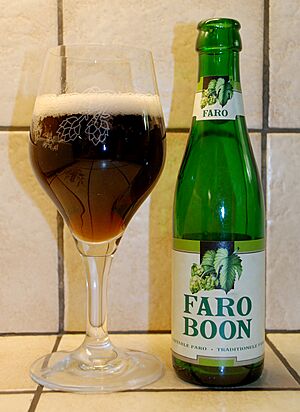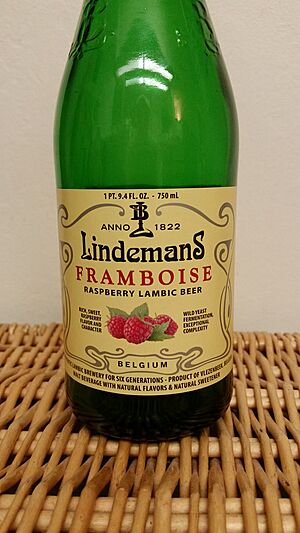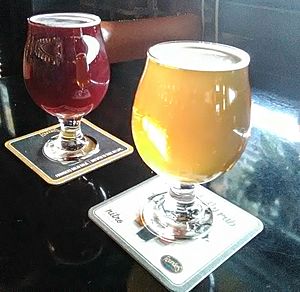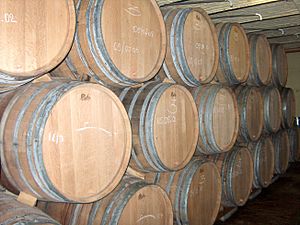Lambic facts for kids
Quick facts for kids Lambic |
|
|---|---|
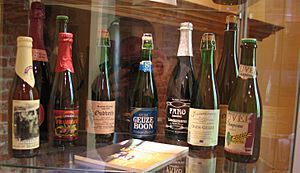
Bottled lambic beers
|
|
| Country of origin | Belgium |
| Yeast type | Spontaneous fermentation |
| Alcohol by volume | 2–8% |
| Color (SRM) | Yellow or pale to deep gold or dark red (when made with certain fruits, see below) |
| Malt percentage | 66% |
Lambic is a unique type of beer made in Belgium. It comes from the Pajottenland region, southwest of Brussels, and from Brussels itself. People have been brewing Lambic since the 13th century!
What makes Lambic different from most other beers? It's all about how it ferments. Instead of using special brewer's yeast, Lambic beer ferments by being open to the air. This lets wild yeasts and bacteria from the Zenne valley get into the beer. This natural process gives Lambic its special taste. It's often dry, a bit like wine or cider, and can have a tart, sour taste.
Contents
What's in a Name?
The word "Lambic" first appeared in 1794 as "allambique." The "a" was soon dropped. By 1811, it was called "lambicq." The name might come from "alembic." This is a type of still used to make strong local drinks like cognac. Some breweries near a village called Lembeek believe the beer's name comes from their village.
How Lambic is Made
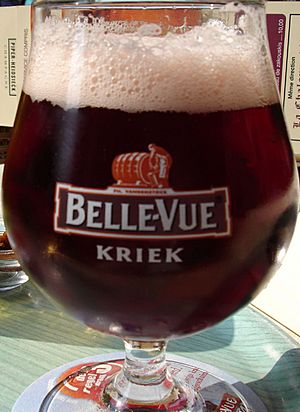
Lambic beer is usually made from a mix of grains. About 60–70% is barley malt. The other 30–40% is unmalted wheat. After mixing the grains, the liquid, called "wort," is cooled. It sits overnight in a wide, flat metal pan called a "coolship." This pan is open to the air. This allows over 120 different tiny living things, called microorganisms, to get into the wort.
This cooling needs cool night temperatures, between -8°C (18°F) and 8°C (46°F). The most important yeasts and bacteria that help the beer ferment live inside the wooden barrels at the breweries. Over eighty different microorganisms have been found in Lambic beer. Some important ones are Saccharomyces cerevisiae and Brettanomyces bruxellensis.
Brewing Lambic usually happens only from October to May. In summer, there are too many unwanted organisms in the air that could spoil the beer. In Brussels, Lambic made after this time is called bezomerd. This means it has had "too much summer." Even Climate change is making this brewing season shorter. In the early 1900s, brewers had about 165 ideal brewing days a year. By 2018, this number dropped to 140 days.
The Role of Hops
For a long time, hops have been used in beer. They help keep the beer fresh and add a nice bitter taste and smell. Lambic beers ferment for a long time. This increases the chance of the beer going bad. So, Lambic brewers use a lot of hops. Hops have properties that fight bacteria.
In the past, Lambic was very hoppy. Today, brewers use old, dry hops. These hops have lost most of their bitterness and strong smell. This way, the beer doesn't taste too much like hops. Instead, Lambic often has a unique, almost cheese-like smell from these old hops.
Aging in Barrels
After the first fermentation, the Lambic is moved into barrels. These are often old port wine or sherry barrels. They are usually made of chestnut or oak wood. Some brewers prefer used wine barrels. The Lambic then ferments and ages for one or more years. A layer of yeast, called a velo de flor, forms on top. This layer helps protect the beer from getting too much air. The barrels are not filled all the way to the top.
Kinds of Lambic Beers
Lambic is usually a mix of at least two different beers. Many producers are "blenders." They buy beer from other brewers and mix them to get the taste they want. For example, a gueuze might have been in different cellars for six years or more. While you might find bottled Gueuze and fruit versions outside Belgium, there are more types available locally. Sometimes, these beers are mixed again or sweetened with sugar or fruit syrups. This is because some can be very tart.
Unblended Lambic
This is Lambic that hasn't been mixed with other beers. It's often cloudy and doesn't have bubbles. It tastes very sour. You rarely find it on tap. When it is on tap, it's called jonge (young) or oude (old). You can find bottled versions from breweries like Cantillon outside Belgium.
Gueuze
Gueuze is a mix of young (one-year-old) and old (two- or three-year-old) Lambics. This blend is then put into bottles. The young Lambic is not fully fermented yet. So, it ferments again in the bottle. This process creates carbon dioxide, which makes the bubbles. A Gueuze needs about a year to get bubbly in the bottle. But it can be kept for 10 to 20 years!
Mars
Mars used to be a weaker beer. It was made from the leftover liquid after making a Lambic. It's not made for sale anymore. In the 1990s, Boon Brewery made a modern Mars beer called Lembeek's 2%. This name referred to its low alcohol content. Now, it's only made for Tilquin to use in their keg beers.
Faro
In the past, Faro was a low-alcohol, sweetened beer. It was made by mixing Lambic with a much lighter, freshly brewed beer. Brown sugar (or sometimes caramel or molasses) was added. The fresh beer was called meertsbier. This made Faro a cheap, light, and sweet drink for everyday use.
The sugar was usually added right before drinking. So, it didn't add bubbles or more alcohol. The 19th-century poet Charles Baudelaire said Faro had a bad aftertaste. He thought Faro in Brussels was made from river water that was also used as a sewer.
Today, Faro still uses brown sugar and Lambic. But it's not always a light beer. Modern Faro is bottled, sweetened, and treated to stop it from fermenting again in the bottle. You can find Faro from breweries like Cantillon, Boon, and Lindemans.
Kriek
Kriek is a type of Lambic made with sour cherries. The Lambic ferments again with the cherries. This second fermentation happens in the bottle. Traditional Kriek beers are dry and sour, just like traditional Gueuze.
Fruit Lambic
Lambic can also be made with other fruits. These include raspberry (called framboise), peach (pêche), blackcurrant (cassis), grape (druif), or strawberry (aardbei). The fruit can be whole or in syrup form. These fruit Lambics are usually bottled and ferment again.
Other, less common fruit flavors include apple (pomme), banana (banane), pineapple (ananas), and blueberry (myrtille). While fruit Lambics are famous, not all fruit beers are made from Lambic. For example, some fruit beers use a different base beer called an oud bruin.
Many newer fruit beers made from Lambic are not considered high quality by beer fans. These often have artificial sweeteners, artificial bubbles, and are made from syrups instead of real fruit.
Where Lambic is Made
Lambic beers are only made near Brussels. This is because of the special natural tiny living things (microflora) in that area. The number of places making Lambic has dropped a lot. In 1900, there were over 300 producers. Now, there are far fewer. An organization called HORAL supports and promotes Lambic production.
Breweries that Make Lambic
Here are some Belgian breweries that make Lambic:
- Belle-Vue, in Sint-Pieters-Leeuw
- Boon, in Lembeek
- Cantillon, in Brussels
- Mort Subite, in Kobbegem
- Girardin, in Sint-Ulriks-Kapelle
- Lindemans Brewery, in Vlezenbeek
- Timmermans, in Itterbeek
- Van Honsebrouck, in Ingelmunster (makes St. Louis beers)
- 3 Fonteinen, in Beersel
Lambic Blenders
These places buy Lambic from brewers and mix it:
- Tilquin, in Rebecq
- De Cam, in Gooik
- Hanssens Artisanaal, in Dworp
- Oud Beersel, in Beersel (their beer is brewed by Boon)
See also
 In Spanish: Lambic para niños
In Spanish: Lambic para niños



